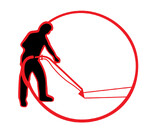The Big Takeaways:
Watch for the signs. Droppings, gnaw marks, scratching, and nests point to active mice in your home.
Hard to handle alone. Mice squeeze through tiny gaps, multiply quickly, and outsmart most DIY fixes.
Call in the experts. Dan's Property Services Ltd provides lasting solutions with proven materials, treatments, and monitoring.
Signs of Mice You Shouldn’t Ignore
It starts small: a midnight scratch, a torn chip bag, a few specks along the baseboard. So, you set traps, tidy the pantry., For a week or two, the scratching stops and droppings disappear. Then it starts again. When mice keep coming back, there’s a pattern behind it. Spotting the signs of mice early is the first step to eliminating the problem at the source.
Mice like quiet cover, steady access to food, and tight, predictable routes. Look for small, rice-shaped droppings on baseboards or inside cabinets and drawers, fresh gnaw marks on chip bags or pet food, light scratching in walls or ceilings, and nests made of paper, fabric, or insulation tucked behind appliances or dark hidden locations that aren’t often disturbed.
You may ask yourself; is this active or old? Fresh droppings are dark, glossy, and slightly soft if pressed with a tissue; older ones turn gray or tan and crumble. New gnaw marks look pale with a few clean shavings nearby, while older chew marks darken and round off. Additionally, a faint ammonia-like odor in small spaces (under sinks, utility closets) also points to recent activity.
Why Adult Mice Are So Hard to Eliminate
All it takes is a dime-size opening for mice to gain entry. Once inside, common structural factors and hidden entry points such as wall voids and gaps around pipes, insulation, spaces behind appliances, and storage clutter offer warm, quiet nesting pockets where activity continues out of sight.
Adult mice aren’t just persistent; they are built to rebound. A single female can produce several litters in a year, with pregnancies that last about three weeks and young that reach breeding age in less than two months. That pace means a seemingly small, quiet problem can turn into a steady population before you notice anything obvious. What feels like “new mice” is often the same family expanding into new rooms.
Why Mice Keep Coming Back Despite Your Efforts
When mice keep coming back, it usually means the combination of conditions that drew them in and helped them thrive persists. DIY steps can quiet things for a few days, but they rarely fix the root causes.
DIY barriers fail fast: Rodents can chew through common quick-fix materials like expandable foam, insulation, plastic, rubber, wood, and standard caulk. So, a gap that looks sealed today can be open again tomorrow. These products can also mask an active opening inside a wall or cabinet, making it harder to spot fresh activity.
Traps aren’t enough: As mice navigate throughout your home, they follow protected edge runways along baseboards, behind appliances, and through utility chases, marking these routes with pheromone trails (urine scent). Traps placed in open areas rarely intersect the edge routes mice actually use, and bait placed in traps competes with more accessible food like pet kibble or open pantry goods—so interest drops fast.
Everyday wear and tear on your home leaves open entry points: A worn seal on the garage door, tiny gaps around pipes or cables, a loose dryer vent, or attic/soffit vents that lead into wall spaces can all give mice entry and cover. Incomplete or improper sealings are open invitations for mice to keep coming back.
Easy food and shelter keep them coming back: Unsealed pantry items, pet bowls left out overnight, and seed or feed improperly stored provide steady calories right next to cover. Cluttered shelves and stacked boxes create safe stopovers along walls. And warm, quiet spots (basements, mechanical rooms, under appliances, and spaces inside walls) let mice rest between trips to food. As long as these rewards remain in place, mice will return.
How to Keep Mice from Coming Back for Good
Use this quick checklist to address common factors that help keep mice from coming back for good. Each item is small on its own; but together, they can make your home harder to re-enter and less rewarding to stay.
Seal gaps and openings: Check door sweeps, garage seals, gaps around pipes and cables, dryer/AC line exits, and foundation vents. Close openings with steel wool plus sealant, metal flashing, or hardware cloth so they don’t reopen.
Lock down food sources: Store pantry items, pet food, bird and lawn seed in hard, tight-lidded containers. Feed pets on a schedule and lift bowls at night. Keep trash lids closed and wipe up crumbs and grease.
Clear edge runways indoors: Pull clutter away from baseboards, lift boxes onto shelves, and keep floors clear. Fewer hiding spots mean fewer safe routes.
Tidy the exterior: Trim shrubs off the foundation, elevate firewood, and secure shed storage. Screen or repair vents and close gaps under steps and decks where mice stage before coming inside.
Make it routine: Do a quick monthly walk-through for fresh droppings, gnawing, rub marks, or new gaps—especially after weather changes or home projects.
When to Call a Mice Exterminator for Lasting Mice Control
If you find activity in more than one room, fresh droppings a week or two after cleanup, or new gnawing near wiring or appliances after trying DIY home remedies, it’s time to call a professional mice exterminator for long-lasting control.
The expert advantage. Unlike DIY methods, professional pest control takes a holistic and targeted approach to getting rid of mice inside your home. A professional visit starts with a whole-property inspection that identifies how mice are using the spaces in and around your home and the gaps that connect them. Then, a thoughtful plan is put into action, focused on sealing off entry points with proven materials, careful bait station placement based on mouse behavior and building layout, and targeted interior and exterior treatment. Multiple treatments are usually necessary to ensure you’re protected, so follow-up inspection and treatments are key.
Conclusion
If you suspect that you have a mouse infestation, call a pest control professional immediately. Because mice can breed quickly, time is of the essence when combatting an infestation.


